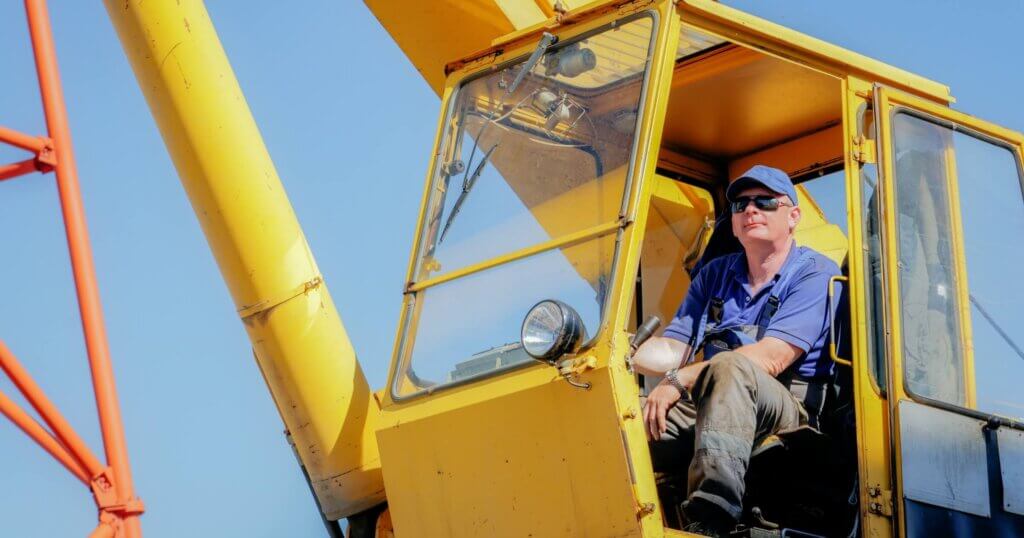Heavy equipment operators across the U.S. need the right credentials to operate cranes legally and safely. Whether you’re aiming to run a mobile crane, tower crane, or overhead system, a crane operator license is your ticket to operating most machines with a lifting capacity of 2,000 pounds or more. Knowing what’s needed, where to train, and how the process works can make all the difference in getting started. In this article we’ll cover how to get a crane operator license, the steps you need to take to get one, and how much a crane operator can make.
Quick look:
- Licensing is required for operating most cranes over 2,000 pounds, including overhead, mobile, and tower cranes.
- Certification involves meeting age and physical requirements, completing accredited training, and passing written and practical exams.
- Trusted training options include NCCCO-accredited centers, union apprenticeships, and specialized private programs.
- State-specific requirements may vary; always verify with local labor departments to stay compliant.
Do you need a license to operate an overhead crane?
If the crane you’re operating can lift 2,000 pounds or more, the answer is yes. You need to be certified. That includes everything from mobile and tower cranes to overhead cranes found in warehouses and industrial settings. OSHA regulations are specific: operators must be properly trained and certified to keep job sites safe, and employers are legally required to make sure their crane operators are qualified for the job.

Image sourced from Shutterstock
Types of crane operator certifications
The type of license you need depends on the kind of crane you’ll be operating. Crane regulations also vary depending on your location.
- Mobile crane operator: Covers machines often used for moving heavy materials around large outdoor job sites, including swing cabs, fixed cabs, and crawler cranes.
- Tower crane operator: These tall, vertical cranes are a staple on high-rise projects and require specialized certification.
- Overhead crane operator: Commonly used in manufacturing or warehouse settings, this includes bridge and gantry cranes that lift and move loads along tracks.
- Articulating crane operator: Also known as knuckle-boom cranes, these are typically mounted on trucks and used for material delivery or lighter-duty lifting.
How to get a crane operator license in 5 easy steps
Getting certified is a straightforward process, but every step matters. Here’s what it typically involves:
- Meet the basic requirements: You must be at least 18 years old, pass a physical exam, and understand English well enough to follow safety instructions.
- Choose your certification type: Decide which class of crane you want to operate: mobile, tower, overhead, or articulating. Each requires a specific certification.
- Enroll in a training program: Look for a program that includes classroom instruction and hands-on crane safety operation to prepare you for the exams.
- Pass the written and practical exams: Exams must be taken through an accredited certifying body like the NCCCO (National Commission for the Certification of Crane Operators).
- Receive your certification card: Once you pass, you’ll receive a crane operator license card valid for five years. To stay qualified, make sure to renew it before it expires.
State-specific licensing requirements
While OSHA sets the baseline for crane operator certification across the U.S., some states go further with their own licensing rules. That means getting NCCCO-certified might not be enough, especially if you plan to work on public projects or in major metro areas.
- New York requires a Crane Operator Certificate of Competence for most construction, demolition, or excavation crane work. Operators must pass a city-issued exam, meet experience requirements, and be medically cleared.
- California recognizes NCCCO certification but may require additional steps depending on the jobsite, employer, or local jurisdiction.
- Washington State has its own crane certification process and requires operators to register with the state Department of Labor & Industries.
Requirements can vary not just by state but sometimes by city or project type, especially in union-heavy regions or areas with dense urban construction.
Pro tip: Always check with your state or local Department of Labor before starting work. Some locations require additional written exams, permits, or ongoing continuing education.
Where to get training and certification
The best program for getting a crane operator license you depends on your goals, location, and the type of crane you want to operate. Here are a few trusted options to consider:
- NCCCO-accredited training centers: These programs follow nationally recognized standards and prepare you for certification with classroom lessons and hands-on crane operation. They’re a solid choice if you want structured, industry-approved training.
- Union apprenticeship programs: If you’re looking for practical experience while you learn, union apprenticeships offer a great blend of classroom instruction and on-site mentorship. Many also provide direct job placement after completion.
- Private training providers: These schools often specialize in specific crane types like tower or articulating cranes and may offer flexible schedules to fit around work or personal commitments.
Pro tip: Choose a program that includes practice exams, safety modules, and career support. Those extras can make a big difference when it’s time to enter the workforce.
How much can a licensed crane operator make?
Crane operators are well-compensated for their skill and responsibility, with wages that reflect both demand and specialization. In the U.S., certified operators earn an average of $29.57 per hour, with annual salaries typically landing around $61,500. Entry-level workers can expect to start closer to $19 per hour, while experienced operators can make over $44 per hour, not including overtime.
In Canada, the average wage for a licensed crane operator is slightly higher at $35.41 per hour, or about $69,000 annually. Provinces like Alberta and B.C. offer some of the top rates, with crane operators earning over $40 an hour on average. Union membership and working on large infrastructure or energy projects can push earnings even higher, making this a solid career path for those with the right training and credentials.
Bottom line
A crane operator license can lead to a well-paying, high-demand career in construction. With the right training and certification, you’ll have the skills and credentials to work safely and legally across a variety of job sites. It’s a smart move that sets you up for long-term success in a field that needs skilled operators now more than ever.
For more tips and industry insights like this, subscribe to our newsletter and stay informed on the latest in training, safety, and skilled trades careers.


